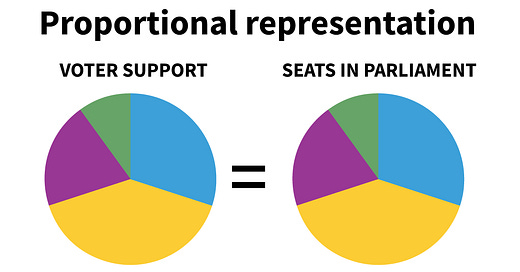
What is Proportional Representation?
Proportional Representation is a means of electing representatives based on their percentage of the vote. The idea behind proportional representation is that everyone has representation, not just the majority.
Different Types of Proportional Representation
Some countries that use the proportional representation system use geography in their elections. In this system, its representatives are not elected based on small geographic areas in winner-take-all elections but instead in often larger geographic areas with multiple winners. These winners frequently represent the proportion of voters who voted for that candidate's party.
Other proportional representation systems do not use geography at all in their elections but, instead, only look at the percentage of the vote that each party received to nominate representatives. This is often used for small countries. In these systems, parties must receive over the percentage threshold (often around 3%) to get seats in their legislative branch.
Pros of the Proportional Election System
In a proportional election system without geographic boundaries, there is no worry about gerrymandering because candidates are not competing in a winner-take-all system, and they are elected in a purely proportional manner. Even in a hybrid system with larger districts and multiple elected candidates, gerrymandering is less of a concern because the geographic areas are larger, and it is not a winner-take-all system.
Furthermore, if you are a political minority in your geographic area, your vote would still matter on a larger scale in this election model. For example, a democratic socialist’s vote would still matter in a conservative area because they would be able to count their vote alongside other democratic socialists in their country. The same logic can also be applied to racial minorities who may not make up a majority in any geographic area, but still reach the threshold on a larger scale.
This model also allows for third parties to become a viable option in national elections. This model also allows for more platform diversity and options for voters.
Drawbacks to Proportional Democracy?
There are however several drawbacks to this system of electing representatives. For one, elections could become more partisan, leading to more political tensions because individuals are voting for a party instead of character.
There are also concerns about a lack of accountability to vote out specific members of a legislative body. Under a geographic system, voters would be able to oust their representatives if they feel they are doing a poor job. This accountability would fall on the parties instead of the voters in this system.
With a lack of geographic representation, there is also a lost sense of approachability with your congresspeople. In short, you can’t call your senator. Voters in this instance would have to contact their party if they feel promises are not being kept.
Who uses Proportional Democracy?
Today, most countries that use a proportional representation system are in Europe and Latin America. However, a total of 73 countries use portions of this system today. There are movements in support in implementing this system in Canada federally and on the state level in the United States.



